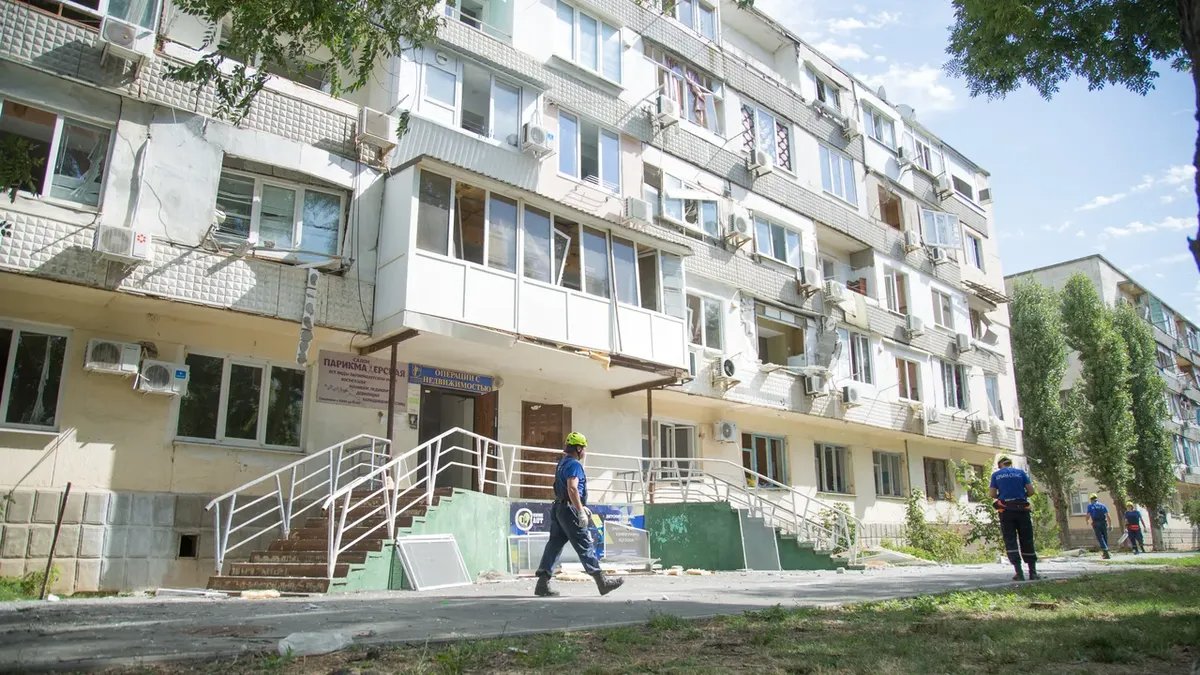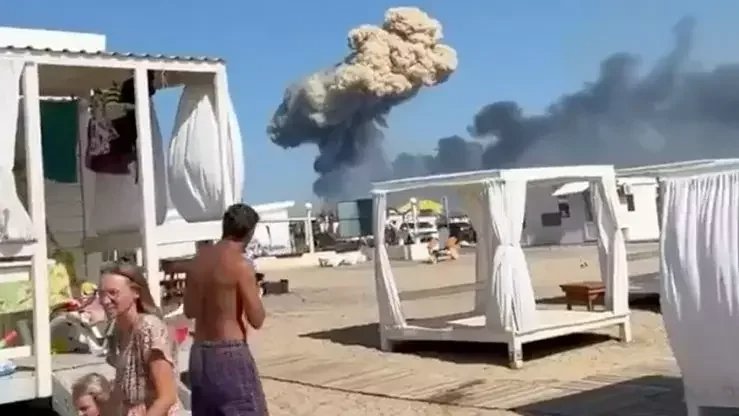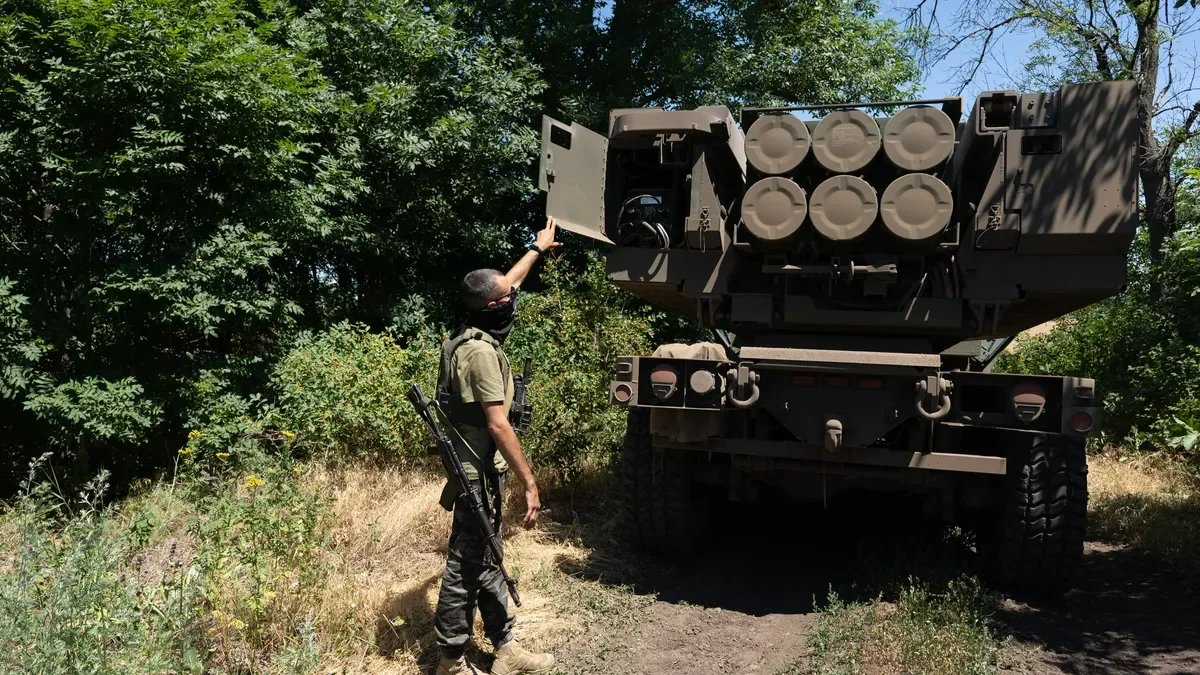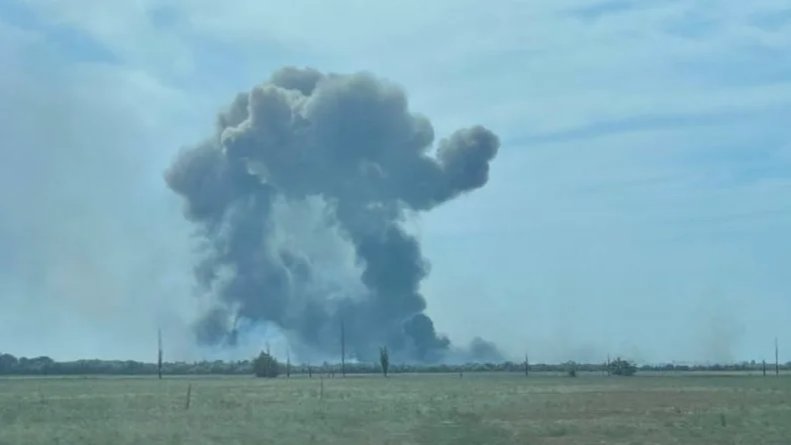In the early hours of 31 July, the headquarters of Russia’s Black Sea Fleet, based in Sevastopol, were attacked by a drone. Several people were injured. The attack kick-started a series of incidents that forced many Russians to reconsider their attitude towards the situation around Crimea. For most of the following days, explosions were heard around the peninsula as air defence systems fired back at incoming drones and projectiles.
Over the course of more than three weeks, attacks rocked air bases and airfields in Novofedorivka (Saki), Belbek, and the village of Hvardiiske. In Dzhankoi, explosions ripped through military depots and damaged a power station and a railway. Air defence systems were triggered in Sevastopol, Kerch, Yevpatoria, Bakhchisarai, Saki and many other towns. On 20 August, the headquarters of Russia’s Black Sea Fleet in Sevastopol was again attacked by a UAV (unmanned aerial vehicle) — a drone crashed into the building, causing a fire.
The shelling of Russia’s Rostov, Belgorod, Kursk and Bryansk regions began back in the spring and continues to this day. Does this series of events mean that the war is increasingly affecting Russian regions and territories that Moscow considers its own? Will the geography and frequency of Ukrainian army attacks expand? We asked the experts. Most of our sources are now in Russia and are unable to speak openly — we have had to quote them anonymously or change their names out of concerns for their safety.
Missiles, drones and saboteurs
From a military point of view, the heaviest damage to the Russian army could be said to have been caused by the attack on the Saki airfield on 9 August. Western intelligence agencies estimate that two powerful explosions took out more than half of the combat aviation of Russia’s Black Sea Fleet. Intelligence has also confirmed that the attack destroyed or severely damaged Su-24MR tactical reconnaissance aircraft responsible for the use of Kalibr missiles, as the firing of these missiles now occurs with a significant delay.
At first, there were reports of rocket fire from an aircraft that had flown up to firing distance. There was also a hypothesis that Ukraine had used its latest development — the Grom-2 missile launcher or the Neptun and Harpoon anti-ship missiles adapted for firing at ground targets. The missile theory is supported by the high explosive yield of the blasts.
However, not a single eyewitness saw the missiles as they supposedly flew up. There was no shortage of them, as people watched in droves and took photos of the incident with their mobile phones from a nearby beach.
The same could be said about the drones.
A kamikaze drone based on an industrial-grade quadcopter could have been used for such an action, as the same has already happened in the attacks on Russian oil depots. These models are highly visible — at least two UAVs would have needed to be used. Moreover, it appears that they would have had to be launched from Crimea, and the devices would have to be somehow delivered or acquired locally — a difficult task in wartime. If this is the case, one can assume that a Ukrainian sabotage network has been deployed to the area for a long time, accumulating strength and resources to start active operations over a number of years, or it has well-established supply channels.
However, the version of the Saki airfield being mined from within seems closer to reality. It is possible that an employee snuck explosives into the military base and planted them in vulnerable locations. This hypothesis explains the precision with which the attacks were carried out.
Guerrilla warfare
According to our source in Kyiv close to the Ukrainian Defence Intelligence (HUR), there are over 10 sabotage and reconnaissance groups operating in the Crimea today under centralised command. Crimeans who left the region after Russia’s annexation make up part of the units, which were dispatched to Zaporizhzhia, Kherson and further across the Perekop Isthmus and the city of Armiansk back in spring this year. They then contacted sleeper agents on site and began preparing for active operations. Saboteurs are professionally trained with excellent knowledge of the area, and, most importantly, are backed by a fairly significant part of the local population. This sabotage network has been in place since March and April and includes 120 to 150 active fighters, as well as several commanders and coordinators.
It is highly likely that the attacks in Dzhankoi and Hvardiiske were also carried out using manually planted explosive devices. According to a Kyiv source, the guerrilla war that has begun is a preparation for a Ukrainian offensive against Kherson, Zaporizhzhia, and Crimea. If a full-scale operation is launched, the saboteurs must destabilise the situation on the peninsula, disrupt military airfields, and cut supply lines and railway traffic.

Shattered windows in a house near the Saki airfield. Photo: Council of Ministers of the Republic of Crimea
United Russia officials and tourists are already starting to flee Crimea. According to reports from Sevastopol, part of the Black Sea Fleet headquarters has been moved to Novorossiysk.
“After Russia attacked Kherson, Zaporizhzia and other regions, Crimea effectively became a frontline region,” explains BBC special correspondent Ilya Barabanov. “In this, [Crimea] is no different from the Russian regions that have been under attack by the Ukrainian side since the start of the conflict. What is extremely surprising are the people who, after six months of war, decide to go on holiday to the peninsula and are confident in their safety. Some even take small children. Their mighty intellect then can’t grasp why a military airfield explodes next to the beach!”
The frontline has remained virtually unchanged for close to a month. Kyiv has officially declared that the Kherson direction is becoming a priority, and expectations are high for an upcoming Ukrainian offensive. “The southern grouping of Russian troops is supplied through Crimea,” Barabanov claims. “Therefore, undermining the Russian army’s supply routes and facilities there is completely justified from a military point of view.” The Ukrainian military says the ban on the use of heavy barrel and rocket artillery on targets in Crimea was lifted on 25 August.
According to our source in Kyiv, Ukraine has assembled more than 90,000-100,000 fighters now in reserve in several central regions of the country.
This group already has a stockpile of ammunition for a month of active combat operations. In the event of an attack on Zaporizhzia, they will be opposed by worn-out units of the Russian army and Russian National Guard. At the same time, the Russian forces in and around Kherson will find themselves in an extremely disadvantageous position — under threat of being cut off from supplies and potentially being completely encircled.
New hotspots
In Russia’s Bryansk, Kursk and Belgorod regions, shelling by various types of Ukrainian weapons has been systematically recorded. Numerous Ukrainian guerrilla units are also operational, often finding sympathisers among local youth — some cooperate for ideological reasons, others for monetary gain, but there is no shortage of support on the ground. “Each group has formed a list of targets and has conducted reconnaissance,” explains our source close to Ukraine’s HRU. “A rapid increase in the number of attacks can be predicted in the event of a surge in hostilities on the fronts. It is likely that many targets earmarked for destruction will blow up almost simultaneously.”
Despite the best efforts of the FSB and other special services, Russia cannot identify and apprehend Ukraine’s saboteurs, or even slow down the wave of explosions — neither in the border regions, nor in Crimea. Russia has military and FSB counterintelligence, as well as a separate counterintelligence unit in the FSB’s Border Service. According to our information, cooperation between these units is rare, as they often compete for the right to profit from smuggling routes and other nefarious activities.
While the Belgorod region is almost directly in the warzone, the Bryansk and Kursk regions also have a relatively long border with Ukraine, which runs through forested and rugged terrain. Russia’s Border Guard Service has virtually no technical means and personnel to completely control the country’s border. The critically small number of drones that are available are often not used due to the danger of losing the expensive equipment or running out of capacity. Novaya Gazeta. Europe can confirm that the Russian military has held drone operator courses without using the actual UAVs themselves.
Another factor worth mentioning is that the locations of all major military units in Russia’s border regions can easily be googled. In Crimea, Russian military units are now stationed where their Ukrainian counterparts were in 2014. Ukraine gets information about the new facilities from satellite imagery as well as from the local population.
“Ukrainian military attacks on Russian territory began almost immediately,” the Volya Telegram channel quoted an anonymous Russian expert as saying. “Remember the bombing of the bridge near Kursk? And the drone strike on the refinery in Novoshakhtinsk? Russian air defences breached by helicopters, followed by strikes on oil depots? Today we are witnessing an increase in the impact of the Ukrainian army on Russian military and strategic facilities. Ukraine’s strikes are targeted, well-planned actions against headquarters, ammunition and armament depots, airfields and fuel infrastructure. Accordingly, military objectives are being pursued first, followed by political ones. Ukraine is showing the whole world its will to resist, along with its determination to crush the enemy — not only on its soil, but also on Russian territory. All this has a propaganda angle designed to have a two-way effect: it encourages Ukrainian citizens and servicemen while sowing panic in the minds of the Russian military and politicians.”
Officially, Kyiv does not admit responsibility for the sabotage and shelling of Crimea. Only anonymous high-ranking sources talk about elite units operating behind enemy lines, and government officials joke about the harm of smoking at ammunition and oil depots.
Interestingly, after numerous and frequent attacks on Crimea, there has been no tangible response from Russia — evidently, the psychological “red line” has been successfully crossed.
Ilya Barabanov, special correspondent for the BBC, highlights the ideological aspect of the attacks: “For eight years there were no explosions in the region. The FSB reported about keeping the opposition and protesters under control. Sevastopol Governor Mikhail Razvozzhayev now spends his days inspecting civil defense facilities and checking up on bomb shelters. While the police harassed Crimean Tatars and arrested fictitious terrorists, the Ukrainians managed to deploy a large-scale and effective subversive network under their noses.”
Barabanov suggests that the sabotage network consists of Crimean Tatars and locals sympathetic to Ukraine who chose to stay on the peninsula in 2014. He stresses that there are several million Ukrainians on Russian territory now, many of whom oppose Moscow’s actions. They could have easily come to Crimea over the bridge and joined the resistance units. Barabanov is confident that these attacks do not require an abundance of explosives or military drones — a small explosive device or a mortar shell can be attached to an ordinary civilian quadcopter and create a serious detonation if launched accurately.
Could these attacks have a key impact on the Russian army’s combat capabilities and possibly turn the tide of war? “On a tactical level, they can do some damage,” says Israeli military expert David Gendelman. “In order to seriously undermine the Russian army’s combat strength, sabotage would have to become much wider and more extensive. Judging by the increase in sabotage in recent weeks, efforts are being made to do just that, so we can expect it to grow and expand even further. The most likely scenario for the next couple of months is a continuation of the slow push. Any sudden advances in offensives and counteroffensives are less likely, in my opinion. Sabotage and shelling can affect [Russian military capability and morale] depending on specific facilities: for example, HIMARS strikes on ammunition depots disrupt the pace of the Russian offensive because it is based on superior firepower and they cannot expend ammunition as much and as fast as they would like as a result of such strikes. The continued destruction of ammunition, fuel and lubricant depots and so on by these or other means could slow down the offensive.”

An explosion in Novofedorivka. Screenshot
Aleksandr Kuznetsov (full name changed), an official of the Russian security services, agreed to comment on the situation: “Parts of the elite that didn’t leave after the occupation receive ‘offers’ that they cannot refuse. Some are blackmailed, some are paid and some are physically threatened. It’s not a problem for sabotage units to enter our territory.”
According to a Russian security official, “refugees” from Ukraine’s State Security Service (the SBU) are quietly wandering around the frontline regions, and there are plenty of people from western Ukraine in Crimea. The soil for sabotage-related recruitment is very fertile, he claims. Our source fears that sabotage may start affecting previously calm Russian regions — major metropolitan areas may become a target.
A Russian military expert quoted by Telegram channel Volya agrees with his evaluation: “In Crimea and the border regions, the population is being harassed about possible links with Ukrainian spies, accusations are being fabricated, while real saboteurs continue their work. Attacks on infrastructure on Russian territory are a regular occurrence. Moreover, as the war drags on and psychological fatigue and the population’s economic woes continue to grow, we should expect an increase in Ukrainian sabotage throughout Russia — from Kaliningrad to Vladivostok. There are and will be people who are ready to do this. The difficulty so far lies in the absence of channels for supplying weapons and explosives. Fuel and transport infrastructure will come under attack. There could be an attack to paralyze the Trans-Siberian railway. There will be explosions and arson at enterprises linked to the military-industrial complex. Lowkey sabotage may also be an issue — damage to equipment, the production of defective parts and entire defence products.”
Hollow shield
The West continues to supply Ukraine with more and more modern high-precision artillery systems and multiple rocket launchers (MRLs) capable of launching projectiles up to 70-80 km. German self-propelled artillery vehicles carrying long-range guided missiles have joined the famous US-made HIMARS. There have been reports about plans to export high-precision American Excalibur projectiles to Ukraine. The weapons supply programme initiated by the West is designed to last for several years. Given Russia’s shell deficit, caused by recent sabotage and depot shelling, accuracy of fire will become increasingly important as the war goes on. There are reports that Russia is already running out of 122 mm ammunition — the basic calibre used by Russian artillery. If this is indeed the case, battlefield superiority is likely to pass to the Ukrainian side.
It is important to note that technical progress accelerates considerably during a war, and it is hard to evaluate what kinds of weapons Ukrainian developers are currently working on. Before the war, Ukraine was trying to upgrade ammunition for the Soviet Smerch MLR, which had a range of 130 km. According to public knowledge, only 120 such projectiles were ever produced — there is no information as to whether all of them have been used so far.

A unit commander points to missiles on a US HIMARS multiple rocket launcher in eastern Ukraine. Photo: Anastasia Vlasova / The Washington Post / Getty Images
The wreckage of an anti-radar HARM missile was recently found near Donetsk. If HIMARS and M270 MLR systems are indeed being supplied with 300 km-range missiles, the only thing that can protect Belgorod, Rostov and other Russian cities is a ban from the US on using the supplied heavy weapons to bombard Russian territory.
In recent days, Russian air defence systems have been active in Sevastopol, Kerch, Dzhankoi and other far-flung parts of the Crimean peninsula. Reports of UAVs being shot down are constantly appearing in the media, as Ukrainian drones fly over Crimea on a daily basis, breaching Russia’s air defence. All the defence echelons the Russian Federation has — including electronic warfare systems — are being probed. According to a Russian military expert, the “impenetrable air defence shield” over Russia is a myth. “Ever since the Cold War, Soviet and Russian air defences have been built to counter the large-scale use of typical US and NATO aircraft,” the expert explains. “This primarily refers to bomber aircraft. We have a solid radar field only from a height of a few kilometres — there are big ‘holes’ below that. [Russia] doesn’t have interceptors on permanent combat duty — all we have is several long-range radar detection aircraft. If we’re talking UAVs, air defence is almost powerless here. The Russian army’s involvement in Syria has shown that several homemade drones made of pine laths and paper — something you would see in a high school aircraft modelling club — were shot down by TOR and Pantsir missiles costing tens of thousands of dollars each. Detection radars often can’t tell them apart from birds.”
“Crimea, which for many years was presented by the Russian side — and by Putin personally — as a symbol of the country’s security, is becoming a target for more and more serious threats,” concludes Ilya Barabanov. “The next stage, when the peninsula becomes ‘a white elephant’, could prove extremely unfortunate for the Kremlin.”
Join us in rebuilding Novaya Gazeta Europe
The Russian government has banned independent media. We were forced to leave our country in order to keep doing our job, telling our readers about what is going on Russia, Ukraine and Europe.
We will continue fighting against warfare and dictatorship. We believe that freedom of speech is the most efficient antidote against tyranny. Support us financially to help us fight for peace and freedom.
By clicking the Support button, you agree to the processing of your personal data.
To cancel a regular donation, please write to [email protected]

